The Preliminary Application of Spectral Microphysics in Numerical Study of the Effects of Aerosol Particles on Thunderstorm Development
Abstract
:1. Introduction
2. Brief Description of the Model
2.1. Microphysics
2.2. Electrical Processes
2.2.1. Electrification Parameterization
2.2.2. Lighting Parameterization
3. Results
3.1. Verification
3.2. Simulation
3.2.1. Initial Condition
3.2.2. Microphysical Processes
3.3. Electrification
3.4. Lightning
4. Discussion
5. Conclusions
- (1)
- The droplets nucleated in the continental polluted background considerably affected the production of a greater number of smaller cloud droplets and led to a narrower droplet spectrum. In polluted conditions, a decline in the mass mixing ratio of ice crystals and a rise in the number of smaller ice crystals are indicated, primarily attributed to weakened ice crystal growth processes. An abundance of smaller droplets leads to less effective riming, decreasing both the concentration and mass mixing ratio of graupel particles, resulting in a narrower spectrum;
- (2)
- Based on the noninductive charging mechanism, the decreasing number of large ice particle (graupel) concentrations and the increasing number of small ice crystals can significantly impair the charge separation mechanism, resulting in a reduced charge density with increasing concentrations of CCN. These results suggest that CCN significantly impacts the strength of charging;
- (3)
- As CCN concentrations increase in the P_N case, the dramatic decrease in large ice particles weakens the charge separation effectiveness. This results in a roughly 43% decrease in lightning frequency and a delay of about 5 min under polluted conditions.
Author Contributions
Funding
Data Availability Statement
Acknowledgments
Conflicts of Interest
References
- Tao, W.K.; Chen, J.P.; Li, Z.; Wang, C.; Zhang, C. Impact of aerosols on convective clouds and precipitation. Rev. Geophys. 2012, 50, RG2001. [Google Scholar] [CrossRef]
- Fan, J.; Wang, Y.; Rosenfeld, D.; Liu, X. Review of aerosol–cloud interactions: Mechanisms, significance, and challenges. J. Atmos. Sci. 2016, 73, 4221–4252. [Google Scholar] [CrossRef]
- Masrour, P.; Rezazadeh, M. Aerosol-cloud-precipitation interaction during some convective events over southwestern Iran using the WRF model. Atmos. Pollut. Res. 2023, 14, 101667. [Google Scholar] [CrossRef]
- Gole, P.K.; Midya, S.K. Association of Pre-Monsoon CG Lightning Activity and Some Surface Pollutants in Different Indian Cities Around the COVID-19 Lockdown Year 2020. Proc. Indian Natl. Sci. Acad. 2021, 87, 657–667. [Google Scholar] [CrossRef]
- Wang, H.; Tan, Y.; Shi, Z.; Yang, N.; Zheng, T. Diurnal differences in the effect of aerosols on cloud-to-ground lightning in the Sichuan Basin. Atmos. Chem. Phys. 2023, 23, 2843–2857. [Google Scholar] [CrossRef]
- Yusfiandika, F.; Lim, S.C.; Gomes, C.; Chockalingam, A.; Pay, L.C. Lightning Behaviour during the COVID-19 Pandemic [version 3; peer review: 2 approved]. F1000 Res. 2021, 10, 906. [Google Scholar] [CrossRef] [PubMed]
- Thornton, J.A.; Virts, K.S.; Holzworth, R.H.; Mitchell, T.P. Lightning enhancement over major oceanic shipping lanes. Geophys. Res. Lett. 2017, 44, 9102–9111. [Google Scholar] [CrossRef]
- Mitzeva, R.; Latham, J.; Petrova, S. A comparative modeling study of the early electrical development of maritime and continental thunderstorms. Atmos. Res. 2006, 82, 26–36. [Google Scholar] [CrossRef]
- Zhao, M.; Austin, P.H. Life cycle of numerically simulated shallow cumulus clouds. Part II: Mixing dynamics. J. Atmos. Sci. 2005, 62, 1291–1310. [Google Scholar] [CrossRef]
- Sun, M.; Liu, D.; Qie, X.; Mansell, E.R.; Yair, Y.; Fierro, A.O.; Yuan, S.; Chen, Z.; Wang, D. Aerosol effects on electrification and lightning discharges in a multicell thunderstorm simulated by the WRF-ELEC model. Atmos. Chem. Phys. 2021, 21, 14141–14158. [Google Scholar] [CrossRef]
- Mansell, E.R.; Ziegler, C.L. Aerosol effects on simulated storm electrification and precipitation in a two-moment bulk microphysics model. J. Atmos. Sci. 2013, 70, 2032–2050. [Google Scholar] [CrossRef]
- Tan, Y.B.; Shi, Z.; Chen, Z.L.; Peng, L.; Yang, Y.; Guo, X.F.; Chen, H.R. A numerical study of aerosol effects on electrification of thunderstorms. J. Atmos. Sol.-Terr. Phys. 2017, 154, 236–247. [Google Scholar] [CrossRef]
- Kessler, E. On the distribution and continuity of water substance in atmospheric circulations. In On the Distribution and Continuity of Water Substance in Atmospheric Circulations; American Meteorological Society: Boston, MA, USA, 1969; pp. 1–84. [Google Scholar] [CrossRef]
- Khain, A.P.; Leung, L.R.; Lynn, B.; Ghan, S. Effects of aerosols on the dynamics and microphysics of squall lines simulated by spectral bin and bulk parameterization schemes. J. Geophys. Res. 2009, 114, D22203. [Google Scholar] [CrossRef]
- Mansell, E.R.; Ziegler, C.L.; Bruning, E.C. Simulated electrification of a small thunderstorm with two-moment bulk microphysics. J. Atmos. Sci. 2010, 67, 171–194. [Google Scholar] [CrossRef]
- Shi, Z.; Tan, Y.B.; Tang, H.Q.; Sun, J.; Yang, Y.; Peng, L.; Guo, X.F. Aerosol effect on the land-ocean contrast in thunderstorm electrification and lightning frequency. Atmos. Res. 2015, 164, 131–141. [Google Scholar] [CrossRef]
- Guo, F.; Li, Y.; Huang, Z.; Wang, M.; Zeng, F.; Lian, C.; Mu, Y. Numerical simulation of 23 June 2016 Yancheng City EF4 tornadic supercell and analysis of lightning activity. Sci. China Earth Sci. 2017, 60, 2204–2213. [Google Scholar] [CrossRef]
- Zhang, J.; Sun, J.M.; Deng, W.; Ma, Y.X. Newly Developed Multiparameter Bulk Cloud Schemes. Part I: A New Triple-Moment Condensation Scheme and Tests. J. Atmos. Sci. 2022, 79, 2645–2684. [Google Scholar] [CrossRef]
- Fan, J.W.; Rosenfeld, D.; Zhang, Y.; Giangrande, S.E.; Li, Z.Q.; Machado, L.A.T.; Martin, S.T.; Yang, Y.; Wang, J.; Artaxo, P.; et al. Substantial convection and precipitation enhancements by ultrafine aerosol particles. Science 2018, 359, 411–418. [Google Scholar] [CrossRef] [PubMed]
- Fan, J.W.; Liu, Y.C.; Xu, K.M.; North, X.K.; Collis, S.; Dong, X.Q.; Zhang, G.J.; Chen, Q.; Kollias, P.; Ghan, S.J. Improving representation of convective transport for scale-aware parameterization: 1. Convection and cloud properties simulated with spectral bin and bulk microphysics. J. Geophys. Res. 2015, 120, 3485–3509. [Google Scholar] [CrossRef]
- Gardiner, B.; Lamb, D.; Pitter, R.L.; Hallett, J.; Saunders, C.P.R. Measurements of initial potential gradient and particle charges in a Montana summer thunderstorm. J. Geophys. Res. 1985, 90, 6079–6086. [Google Scholar] [CrossRef]
- Saunders, C.P.R.; Keith, W.D.; Mitzeva, R.P. The effect of liquid water on thunderstorm charging. J. Geophys. Res. 1991, 96, 11007–11017. [Google Scholar] [CrossRef]
- Leroy, D.; Monier, M.; Wobrock, W.; Flossmann, A.I. A numerical study of the effects of the aerosol particle spectrum on the development of the ice phase and precipitation formation. Atmos. Res. 2006, 80, 15–45. [Google Scholar] [CrossRef]
- Khain, A.P.; Phillips, V.; Benmoshe, N.; Pokrovsky, A. The Role of Small Soluble Aerosols in the Microphysics of Deep Maritime Clouds. J. Atmos. Sci. 2012, 69, 2787–2807. [Google Scholar] [CrossRef]
- Morrison, H.; Witte, M.; Bryan, G.H.; Harrington, J.Y.; Lebo, Z.J. Broadening of modeled cloud droplet spectra using bin microphysics in an Eulerian spatial domain. J. Atmos. Sci. 2018, 75, 4005–4030. [Google Scholar] [CrossRef]
- Shpund, J.; Khain, A.; Lynn, B.; Fan, J.; Han, B.; Ryzhkov, A.; Snyder, J.; Dudhia, J.; Gill, D. Simulating a mesoscale convective system using WRF with a new spectral bin microphysics: 1: Hail vs. Graupel. J. Geophys. Res. 2019, 124, 14072–14101. [Google Scholar] [CrossRef]
- Choi, K.O.; Yum, S.S.; Chang, D.Y.; Yeom, J.M.; Lee, S.S. A study of the effect of regenerated CCN on marine stratocumulus cloud development using the WRF-LES model with spectral bin microphysics scheme. Atmos. Res. 2020, 246, 105100. [Google Scholar] [CrossRef]
- Xue, L.; Teller, A.; Rasmussen, R.; Geresdi, I.; Pan, Z. Effects of aerosol solubility and regeneration on warm-phase orographic clouds and precipitation simulated by a detailed bin microphysical scheme. J. Atmos. Sci. 2010, 67, 3336–3354. [Google Scholar] [CrossRef]
- Xue, L.; Teller, A.; Rasmussen, R.; Geresdi, I.; Pan, Z.; Liu, X.D. Effects of aerosol solubility and regeneration on mixed-phaseorographic clouds and precipitation. J. Atmos. Sci. 2012, 69, 1994–2010. [Google Scholar] [CrossRef]
- Xiao, H.; Yin, Y.; Jin, L.; Chen, Q.; Chen, J. Simulation of the effects of aerosol on mixed-phase orographic clouds using the WRF model with a detailed bin microphysics scheme. J. Geophys. Res. 2015, 120, 8345–8358. [Google Scholar] [CrossRef]
- Reisin, T.; Levin, Z.; Tzivion, S. Rain production in convective clouds as simulated in an axisymmetric model with detailed microphysics. Part I: Description of the model. J. Atmos. Sci. 1996, 53, 497–519. [Google Scholar] [CrossRef]
- Yin, Y.; Levin, Z.; Reisin, T.G.; Tzivion, S. The effects of giant cloud condensation nuclei on the development of precipitation in convective clouds-A numerical study. Atmos. Res. 2000, 53, 91–116. [Google Scholar] [CrossRef]
- Meyers, M.P.; DeMott, P.J.; Cotton, W.R. New primary ice-nucleation parameterizations in an explicit cloud model. J. Appl. Meteorol. Clim. 1992, 31, 708–721. [Google Scholar] [CrossRef]
- Bigg, E.K. The formation of atmospheric ice crystals by the freezing of droplets. Q. J. R. Meteorol. Soc. 1953, 79, 510–519. [Google Scholar] [CrossRef]
- Mossop, S.C. The influence of drop size distribution on the production of secondary ice particles during graupel growth. Q. J. R. Meteorol. Soc. 1978, 104, 323–330. [Google Scholar] [CrossRef]
- Morrison, H.; Gettelman, A. A new two-moment bulk stratiform cloud microphysics scheme in the Community Atmosphere Model, version 3 (CAM3). Part I: Description and numerical tests. J. Clim. 2008, 21, 3642–3659. [Google Scholar] [CrossRef]
- Saunders, C.; Peck, S. Laboratory studies of the influence of the rime accretion rate on charge transfer during crystal/graupel collisions. J. Geophys. Res. 1998, 103, 13949–13956. [Google Scholar] [CrossRef]
- Mansell, E.R.; MacGorman, D.R.; Ziegler, C.L.; Straka, J.M. Simulated three-dimensional branched lightning in a numerical thunderstorm model. J. Geophys. Res-Atmos. 2002, 107, ACL 2-1–ACL 2-12. [Google Scholar] [CrossRef]
- Tan, Y.B.; Tao, S.C.; Zhu, B.Y. Fine-resolution simulation of the channel structures and propagation features of intracloud lightning. Geophys. Res. Lett. 2006, 33, L09809. [Google Scholar] [CrossRef]
- Tan, Y.; Tao, S.; Liang, Z.; Zhu, B. Numerical study on relationship between lightning types and distribution of space charge and electric potential. J. Geophys. Res. 2014, 119, 1003–1014. [Google Scholar] [CrossRef]
- Tan, W.; Yin, Y.; Guo, L.; Gu, J.; Fu, S.; Dong, L. Analysis of the micro-physical characteristics of aerosol particles in clean and pollution area in summer of Nanjing. Environ. Sci. Technol. 2010, 33, 280–286, (In Chinese with Abstract in English). [Google Scholar]
- Qin, Y.; Yin, Y.; Yang, S.; Chen, K. Chemical characteristics of the aerosols and their effect on microphysical properties of clouds in spring and summer over Mt. Huang. Acta Meteorol. Sin. 2012, 70, 1334–1346, (In Chinese with English Abstract). [Google Scholar]
- Sun, J.; Ariya, P.A.; Leighton, H.G.; Yau, M.K. Modeling study of ice formation in warm-based precipitating shallow cumulus clouds. J. Atmos. Sci. 2012, 69, 3315–3335. [Google Scholar] [CrossRef]
- Sun, J.; Leighton, H.; Yau, M.K.; Ariya, P.A. Numerical evidence for cloud droplet nucleation at the cloud-environment interface. Atmos. Chem. Phys. 2012, 12, 12155–12164. [Google Scholar] [CrossRef]
- Wang, G.; Wang, H.; Yu, Y.; Gao, S.; Feng, J.; Gao, S.; Wang, L. Chemical characterization of water-soluble components of PM10 and PM2.5 atmospheric aerosols in five locations of Nanjing, China. Atmos. Environ. 2003, 37, 2893–2902. [Google Scholar] [CrossRef]
- Wen, B. The Chemical Characteristics of Aerosol and Fog/Cloud at Mount Huangshan. Master’s Thesis, School of Atmospheric physics, Nanjing University Information Science and Technology, Nanjing, China, 2013. (In Chinese). [Google Scholar]
- Yau, M.K. A two-cylinder model of cumulus cells and its application in computing cumulus transports. J. Atmos. Sci. 1980, 37, 2470–2485. [Google Scholar] [CrossRef]
- Yang, Y.; Sun, J.; Li, F.; Zhang, T.; Hu, W.; Zhang, J. A numerical study of effects of aerosol particles on the electric activities of a thunderstorm with a 1.5 D aerosol-cloud bin model. J. Aerosol. Sci. 2022, 162, 105975. [Google Scholar] [CrossRef]
- Andreae, M.O.; Rosenfeld, D.; Artaxo, P.; Costa, A.A.; Frank, G.P.; Longo, K.M.; Silva-Dias, M.A.F. Smoking rain clouds over the Amazon. Science 2004, 303, 1337–1342. [Google Scholar] [CrossRef] [PubMed]
- Van den Heever, S.C.; Carrió, G.G.; Cotton, W.R.; DeMott, P.J.; Prenni, A.J. Impacts of nucleating aerosol on Florida storms. Part I: Mesoscale simulations. J. Atmos. Sci. 2006, 63, 1752–1775. [Google Scholar] [CrossRef]
- Khain, A.; Rosenfeld, D.; Pokrovsky, A. Aerosol impact on the dynamics and microphysics of deep convective clouds. Q. J. R. Meteorol. Soc. 2005, 131, 2639–2663. [Google Scholar] [CrossRef]
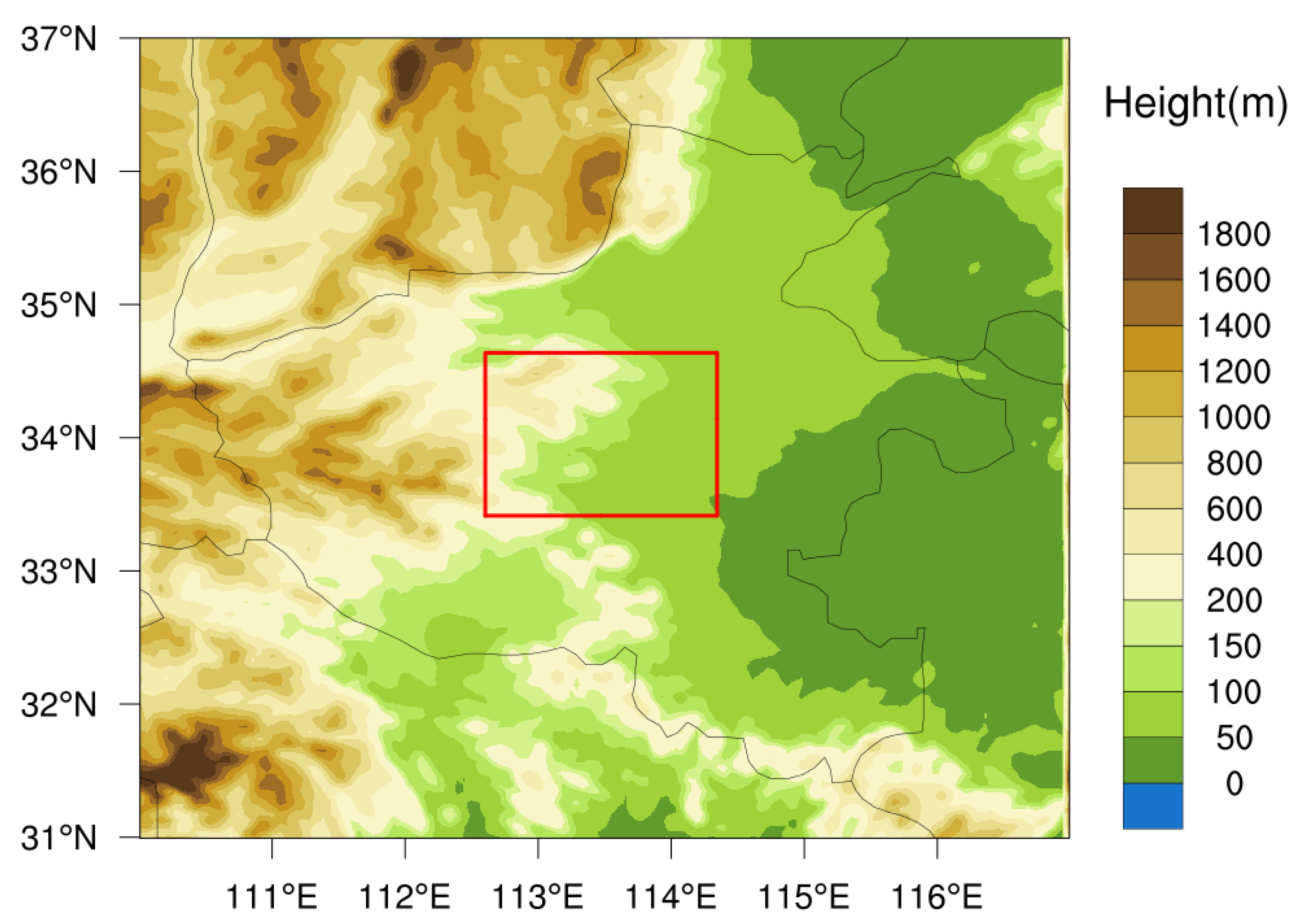




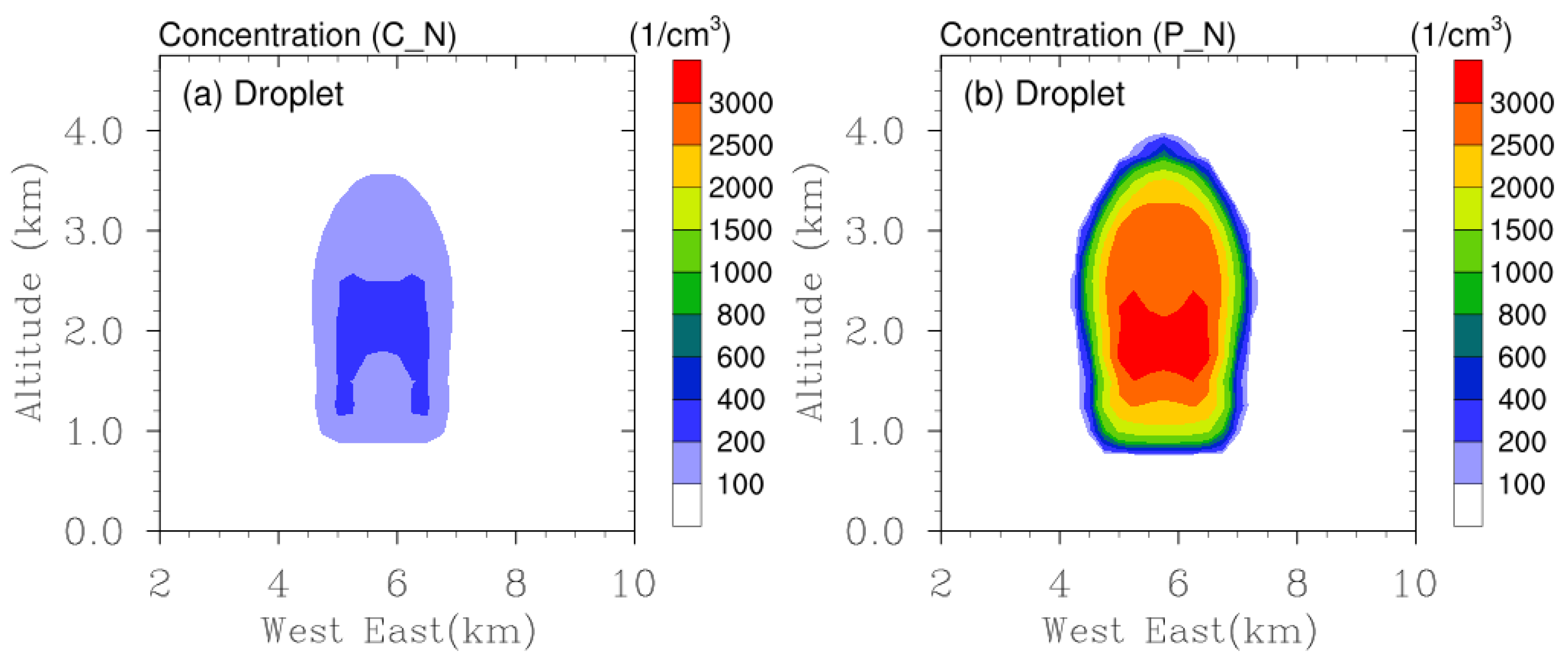
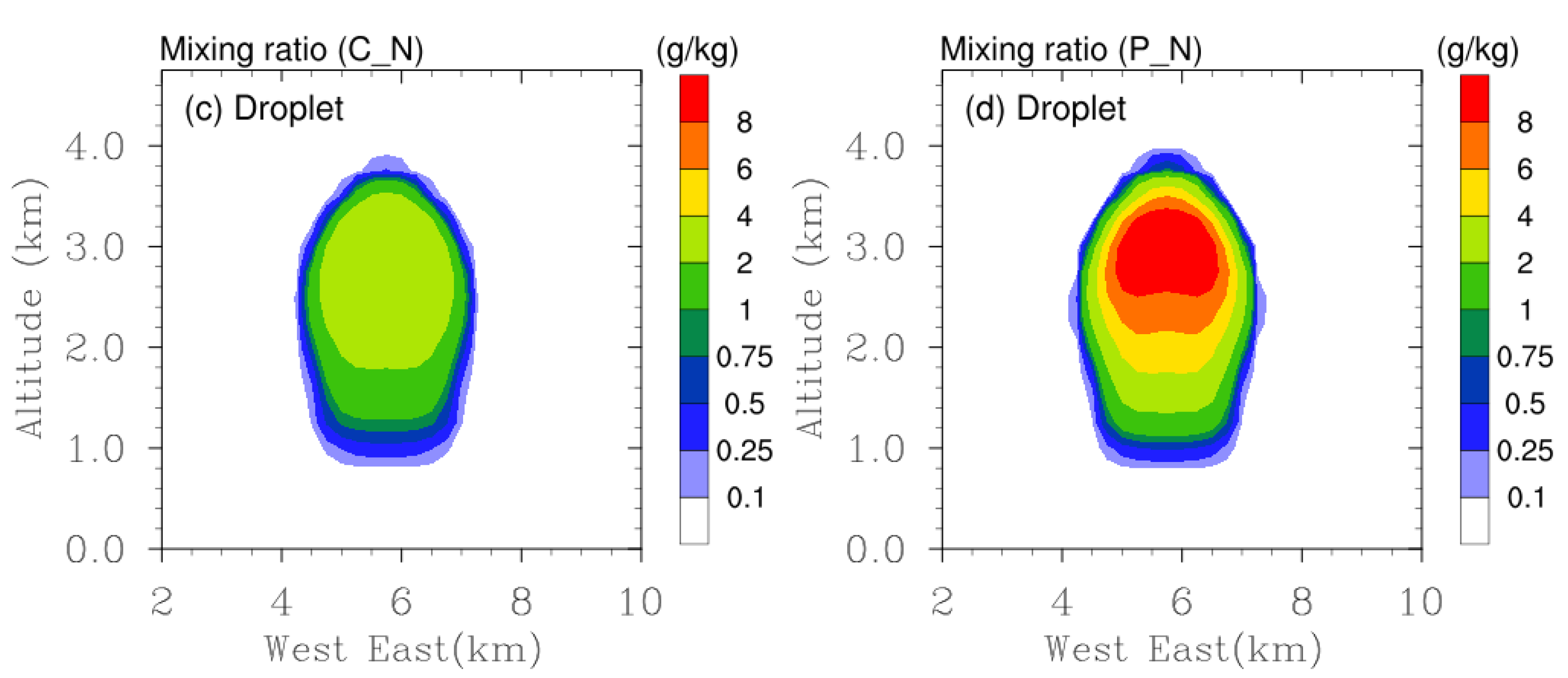
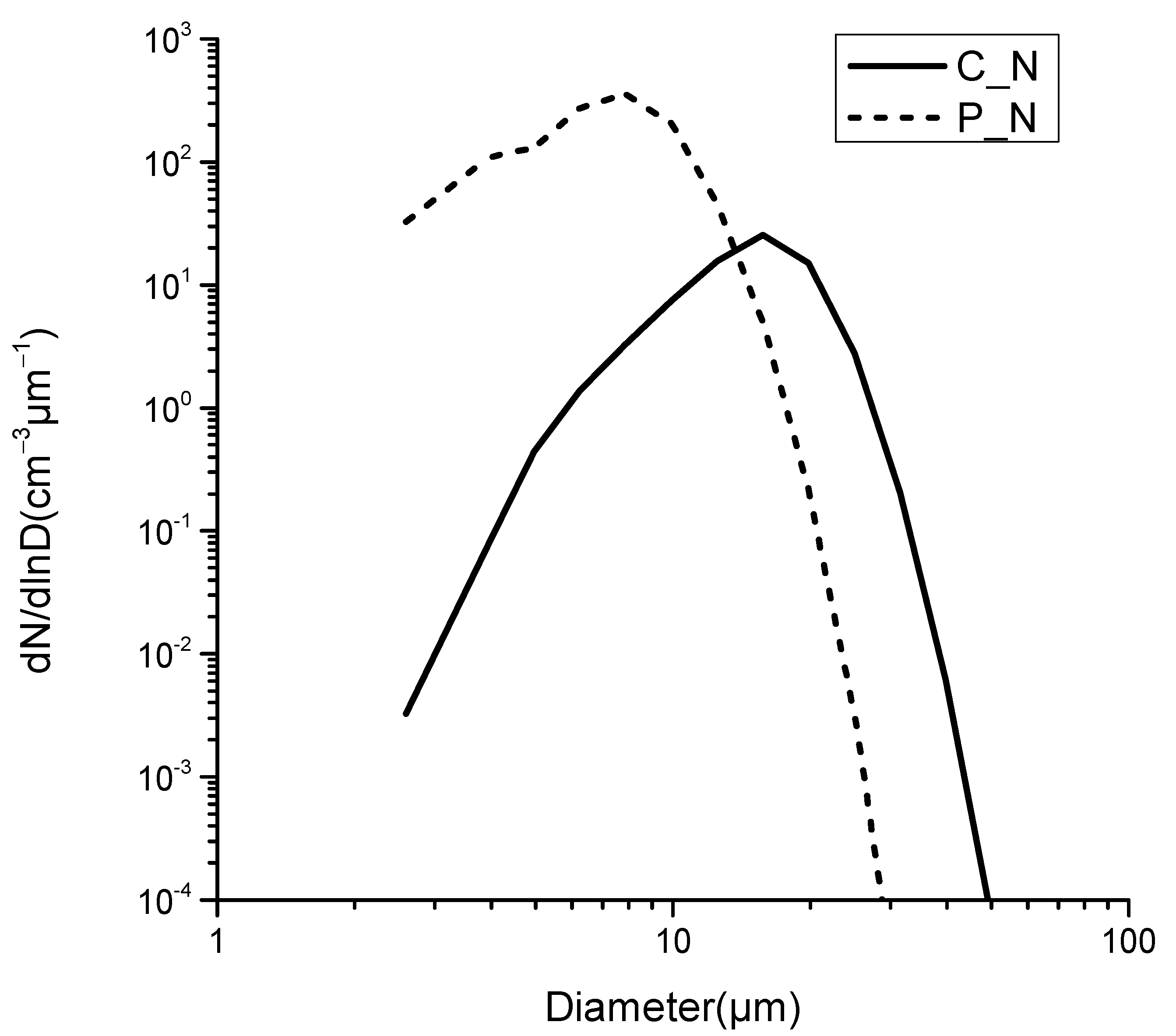
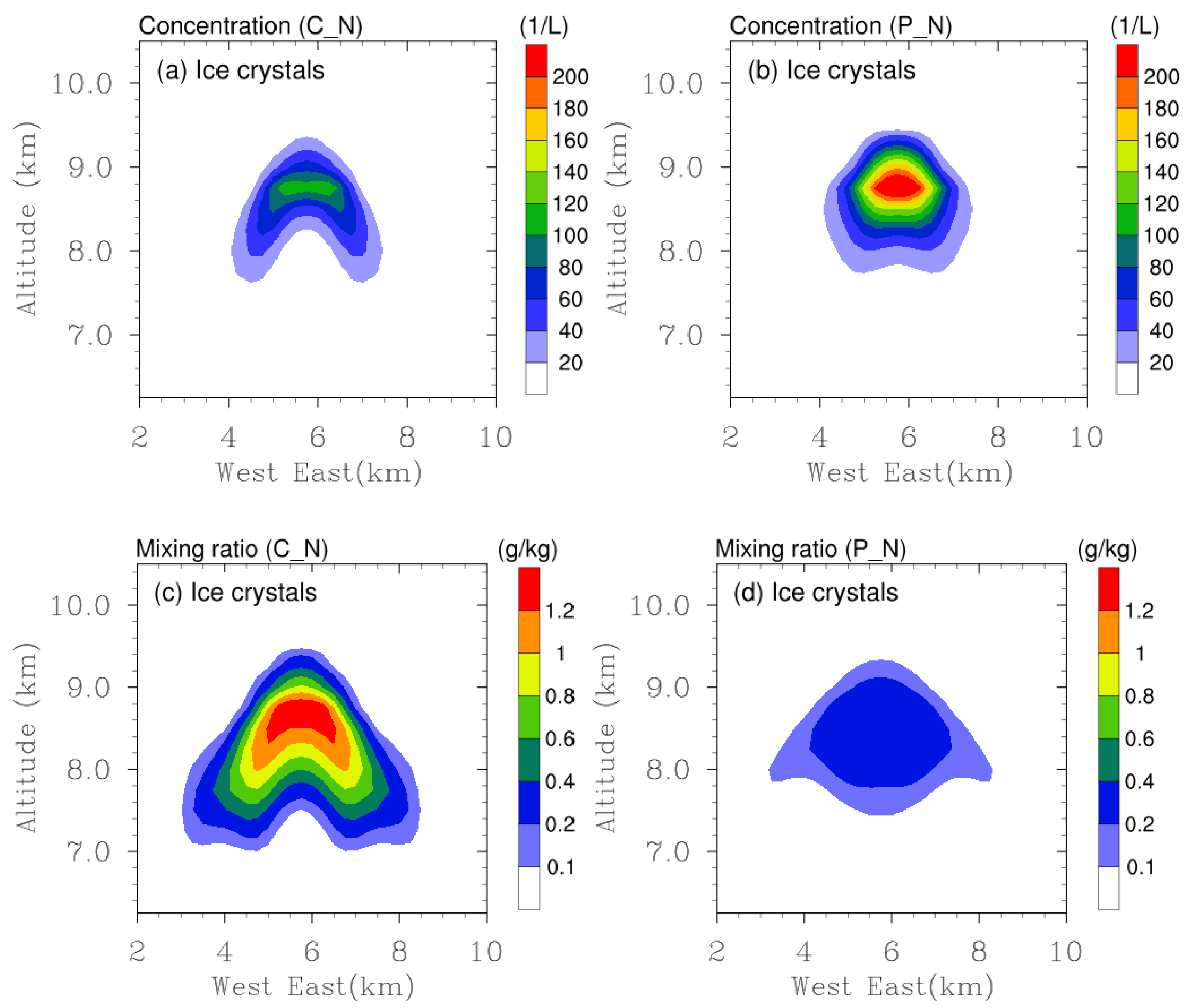
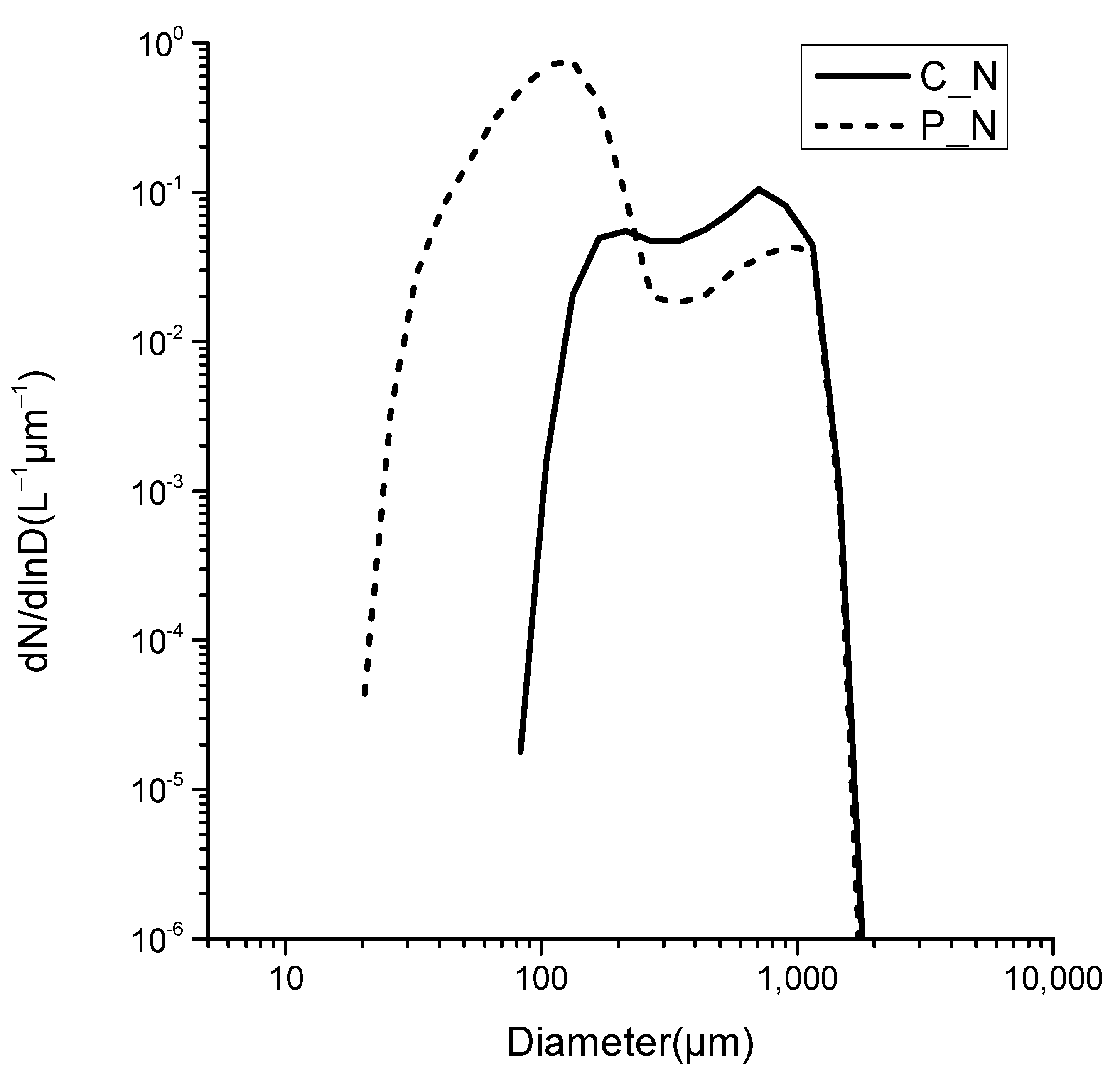
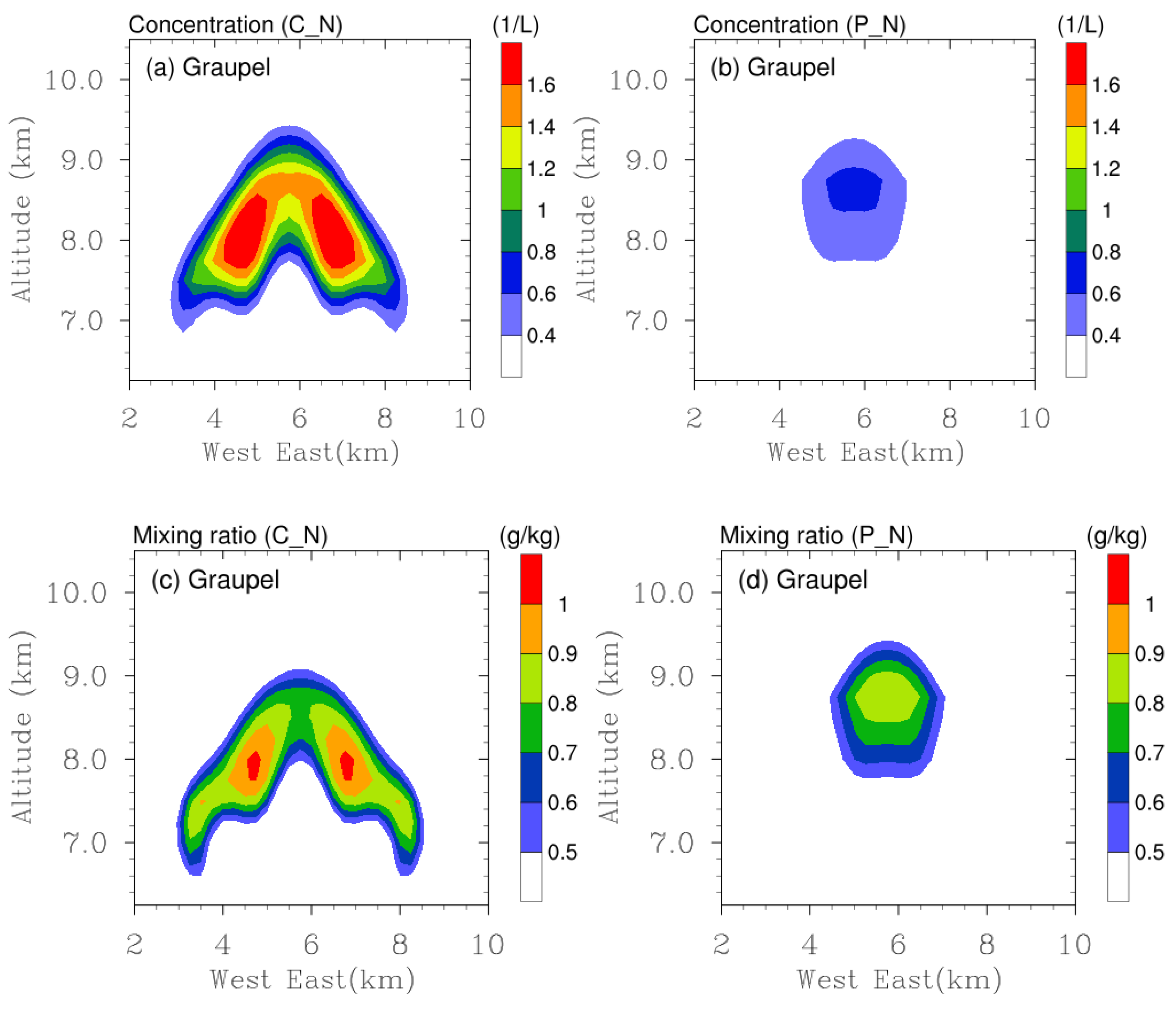
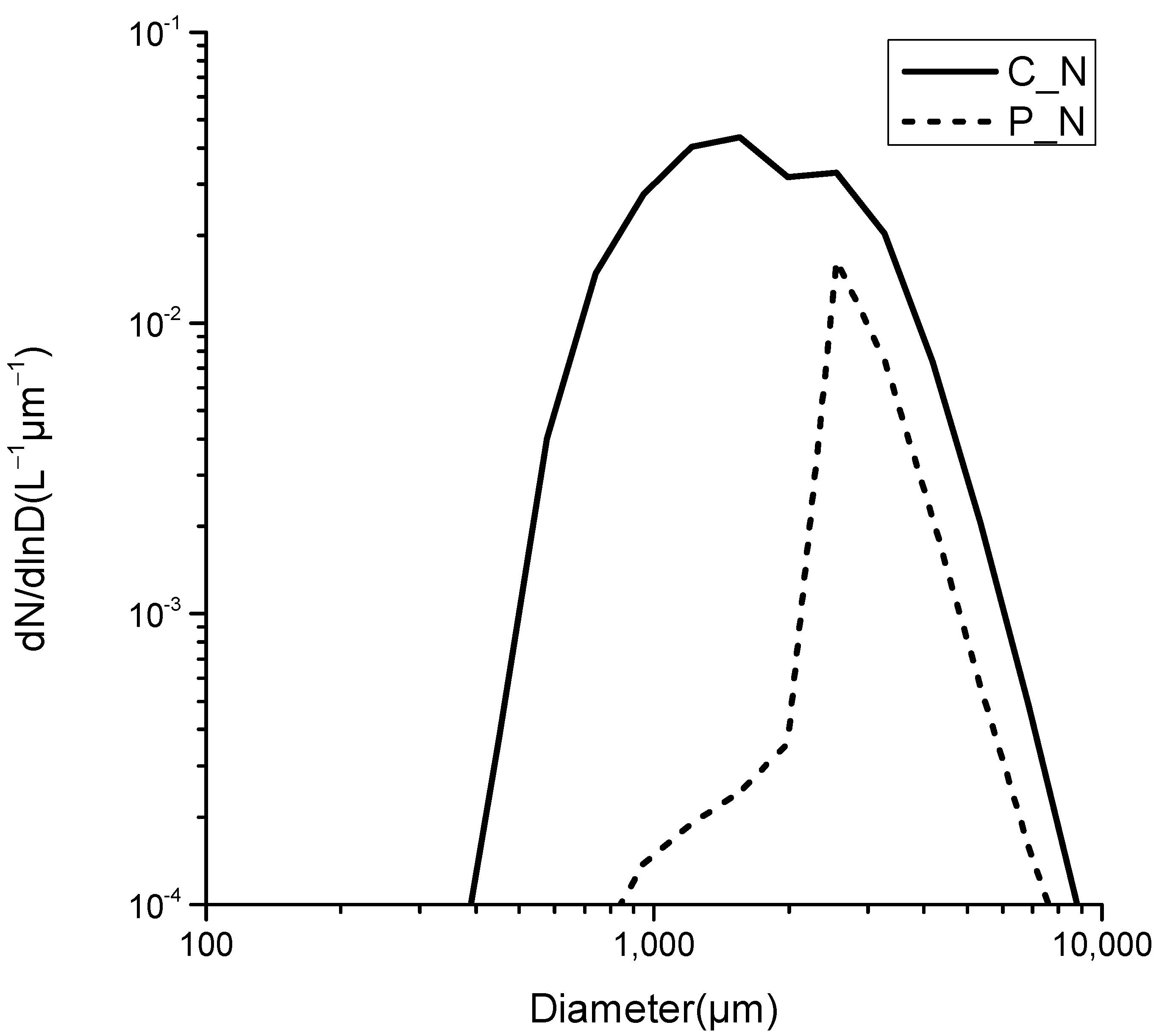


| Parameter | Description |
|---|---|
| Nesting | Two-way nesting |
| Horizontal grid spacing | Domain 1: 6 km Domain 2: 2 km |
| Grid points | Domain 1: 133 × 100 Domain 1: 138 × 85 |
| Timestep | Domain 1: 24 s Domain 2: 8 s |
| Top pressure | 50 hPa |
| Cloud microphysics | Morrison two-moment bulk microphysics self-coupled spectral (bin) microphysics |
| Cumulus | Kain–Fritsch |
| Planetary boundary layer | MYJ |
| Surface layer | Mellor–Yamada–Janjic (Eta) TKE |
| Land surface | RUC |
| Longwave radiation | CAM |
| Shortwave radiation | CAM |
| Mode | ni (cm−3) | Ri (μm) | log σi | |
|---|---|---|---|---|
| 1 | 588.6 | 0.0083 | 0.0841 | |
| clean background | 2 | 1425.2 | 0.0167 | 0.1983 |
| 3 | 882.1 | 0.094 | 0.2371 | |
| 1 | 40,000.9 | 0.0168 | 0.2615 | |
| polluted background | 2 | 8781.2 | 0.052 | 0.185 |
| 3 | 66.7 | 0.129 | 0.1646 |
Disclaimer/Publisher’s Note: The statements, opinions and data contained in all publications are solely those of the individual author(s) and contributor(s) and not of MDPI and/or the editor(s). MDPI and/or the editor(s) disclaim responsibility for any injury to people or property resulting from any ideas, methods, instructions or products referred to in the content. |
© 2024 by the authors. Licensee MDPI, Basel, Switzerland. This article is an open access article distributed under the terms and conditions of the Creative Commons Attribution (CC BY) license (https://creativecommons.org/licenses/by/4.0/).
Share and Cite
Yang, Y.; Sun, J.m.; Shi, Z.; Tian, W.s.; Li, F.x.; Zhang, T.y.; Deng, W.; Hu, W.; Zhang, J. The Preliminary Application of Spectral Microphysics in Numerical Study of the Effects of Aerosol Particles on Thunderstorm Development. Remote Sens. 2024, 16, 2117. https://doi.org/10.3390/rs16122117
Yang Y, Sun Jm, Shi Z, Tian Ws, Li Fx, Zhang Ty, Deng W, Hu W, Zhang J. The Preliminary Application of Spectral Microphysics in Numerical Study of the Effects of Aerosol Particles on Thunderstorm Development. Remote Sensing. 2024; 16(12):2117. https://doi.org/10.3390/rs16122117
Chicago/Turabian StyleYang, Yi, Ji ming Sun, Zheng Shi, Wan shun Tian, Fu xing Li, Tian yu Zhang, Wei Deng, Wenhao Hu, and Jun Zhang. 2024. "The Preliminary Application of Spectral Microphysics in Numerical Study of the Effects of Aerosol Particles on Thunderstorm Development" Remote Sensing 16, no. 12: 2117. https://doi.org/10.3390/rs16122117





